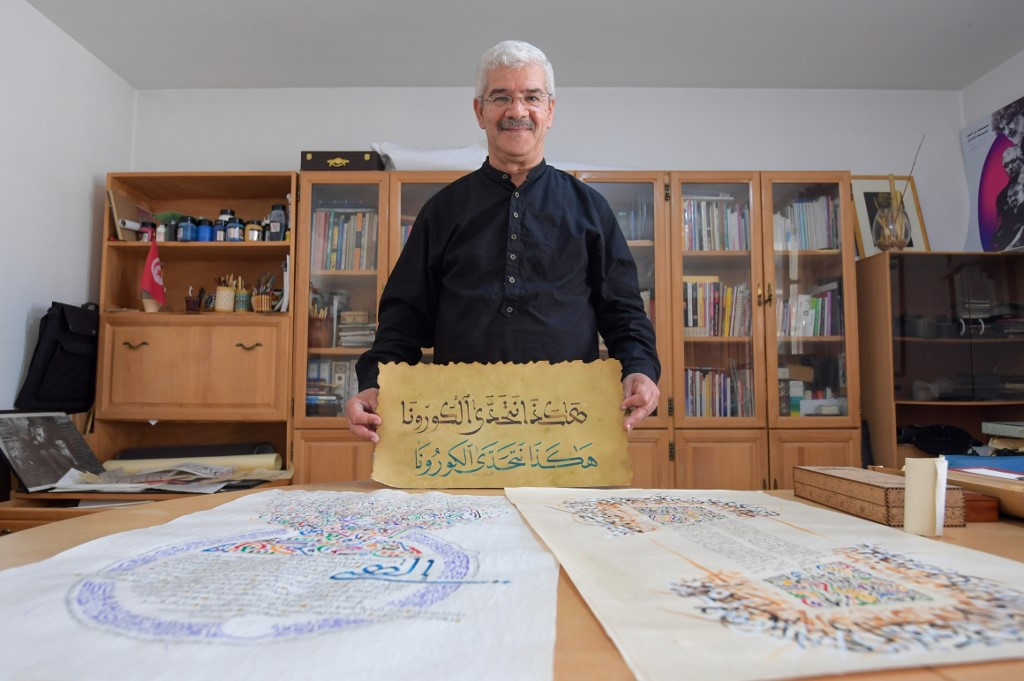Popular Reads
Top Results
Can't find what you're looking for?
View all search resultsPopular Reads
Top Results
Can't find what you're looking for?
View all search resultsTunisia rediscovers traditional art of calligraphy
Change text size
Gift Premium Articles
to Anyone
T
unisia's president has become a surprise champion of Arabic calligraphy in his country, shining a light on the artistic tradition as Arab states lobby for its recognition by UNESCO.
President Kais Saied sparked both admiration and mockery on social media when images emerged of hand-written presidential letters on official paper not long after he took office in October last year.
An academic with a keen interest in the art form, Saied had studied with well-known Tunisian calligrapher Omar Jomni.
To prove that Saied had penned the documents himself, the presidency released a video showing him writing in a guest book.
The president "writes official correspondence in maghrebi script and private letters in diwani", Jomni said, referring to two forms of Arabic calligraphy.
Maghrebi script is a form of the older, angular style of Kufic calligraphy, while diwani is a more ornamental Ottoman style popular for poetry.
The president's "recognition" of calligraphy has warmed artists' hearts, Jomni said, giving them hope for a brighter future for an art form that was like "a closed book".
Read also: Jakartans find relief from urban stress in classic calligraphy
Not just a 'technical skill'
Calligraphy in Tunisia lacks the prominence it enjoys in some other Arab countries -- such as in the Gulf -- and its National Centre of Calligraphic Arts, created in 1994, risks closing its doors.
With a lack of instructors, courses will likely have to end this year, according to the institute's head, Abdel Jaoued Lotfi.
"There are not enough professional calligraphers in Tunisia," said calligraphy master Jomni, who is in his sixties.
"You can count them on one hand and they are working in precarious conditions."
Sixteen Arab countries, including Tunisia, Egypt, Iraq and Saudi Arabia, have prepared a proposal to have Arabic calligraphy inscribed on the UNESCO list of humanity's intangible cultural heritage.
It's a chance to consider calligraphy "as a whole culture and living heritage... and not just as a simple technical skill", said Imed Soula, a researcher overseeing Tunisia's submission to the UN cultural body.
He said Tunisia's fading calligraphy practice, which traditionally saw artists tackle surfaces like copper or stone, was also linked to the growing use of new technologies, some of which have moved it away from its performing-art dimension.
But Jomni said calligraphy in Tunisia suffered from "the brutal and chaotic marginalization of Islamic culture during the '60s, whose repercussions we still feel today".
Read also: Islamic calligraphy exhibition seeks to restore compassion in fast-paced world
Updating tradition
The country's first president, Habib Bourguiba (1957-1987), dismantled and divided up the Islamic University of Ez-Zitouna after a power struggle with its clerical leadership.
Books and manuscripts from the institute, then Tunisia's main Arab-language university and one of the most important in the Muslim world, were seized.
Tunisian calligrapher Mohamed Salah Khamasi studied there at the start of the 20th century and laid down the foundations for calligraphy in the country, passing his knowledge on to several generations.
Following the 2011 revolution that set Tunisia on the road to democracy, a young generation of calligraphers is now calling for a reinvention of the art form to reflect the spirit of the times -- "so that it doesn't get rusty and outdated", Karim Jabbari told AFP.
The artist in his thirties is known internationally for his large-scale calligraphy works, often created with light using long-exposure photography, or in mural form.
In 2011, in his marginalized hometown of Kasserine, which saw deadly clashes before the fall of longtime autocrat Zine El Abidine Ben Ali, Jabbari used light to write the names of protesters in the places where they were killed.
"Through this form of calligraphy, I want to highlight the beauty of the Arabic language and bring it closer to people," Jabbari said -- and "keep our heritage firmly anchored in our memory".











